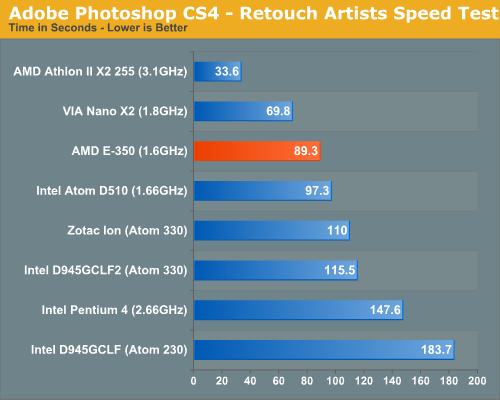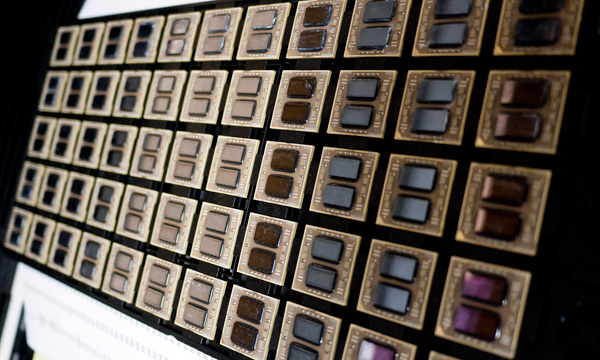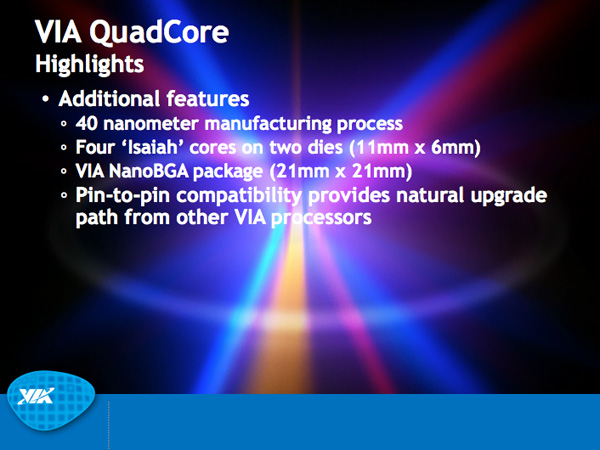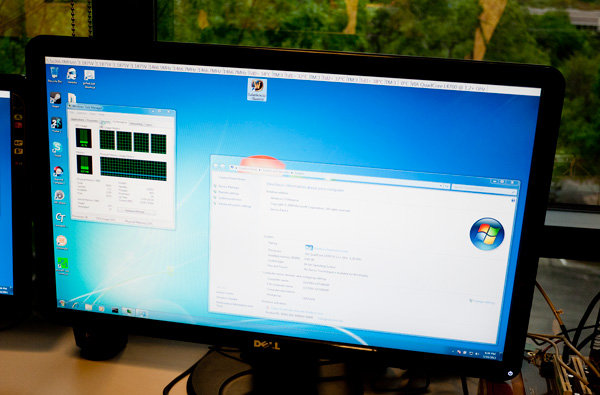VIA's QuadCore: Nano Gets Bigger
by Anand Lal Shimpi on May 12, 2011 3:01 AM ESTTwo days ago I flew out to VIA's Centaur headquarters in Austin, Texas to be briefed on a new CPU. When I wrote about VIA's Dual-Core Nano I expected the next time we heard from VIA about CPUs to be about its next-generation microprocessor architecture. While Nano still holds a performance advantage over Atom and Bobcat, it's still missing a number of key architectural innovations that both Intel and AMD have adopted in their current generation hardware (e.g. GPU integration, power gating).

VIA's dual-core Nano, faster than AMD's E-350 and Intel's Atom
Much to my surprise, the meeting wasn't about VIA's next-generation microprocessor architecture but rather the last hurrah for Nano: a quad-core version simply called the VIA QuadCore.
VIA's QuadCore architecture is nothing too surprising. At a high level the chip is composed of two dual-core die connected by a shared 1333MHz FSB, very similar to the old dual-core Pentium D processors. Each dual-core die has two 1MB independent L2 caches, for a total of 4MB of L2 on-package.

VIA's QuadCore, in production today
Going a little deeper there's an AMD-like 64KB L1 instruction and 64KB L1 data cache per core. The Nano is of course fully 64-bit x86 compatible, supporting up to SSE4. Each core is a 3-issue out-of-order design, giving it a general throughput and performance advantage over Intel's Atom and AMD's Bobcat. Remember that Atom is a 2-issue in-order architecture and Bobcat is 2-issue out-of-order. The wider front end for Nano gives VIA the ability to perform well in more complex workloads.

In the past power consumption has been an issue for VIA's Nano, however the QuadCore is built on a 40nm process which helps reel in power consumption. At 1.2GHz, VIA's QuadCore still carries a 27W TDP. Add another 5W for the integrated graphics chipset and you're talking about 32W, nearly double of AMD's dual-core E-350 Brazos platform. VIA claims that at lower clock speeds it can significantly reduce TDP, however the 1.2GHz QuadCore is the only part being announced today.
VIA is calling the 1.2GHz part a 1.2GHz+ QuadCore since it can use available TDP headroom to overclock itself by up to another two bins (133MHz per bin - 1.46GHz max). The chip doesn't support power gating, just aggressive clock gating.

Like all Nano parts, the QuadCore features a hardware AES encryption engine. VIA has added support for SHA-384 and SHA-512 as well.
Although there are still a considerable number of dual-core platforms sold in the market today, designs with four beefy processor cores seem to be where the world as a whole is headed. With its 2011 15/17-inch MacBook Pro and iMac updates, Apple no longer offers a dual-core option in those systems. By the time we move to 22nm I wouldn't be too surprised if the 13-inch MacBook Pro was quad-core only as well.
VIA moving to four cores makes sense and the QuadCore design was an obvious step. Even Intel used a dual-die approach to make the most of its existing microprocessor design before starting from scratch for Nehalem.
As odd as it sounds, VIA's QuadCore actually has a small but viable position in the market. At 27.5W the TDP is too high for a tablet like the iPad, and its performance will be too low to compete with ultra portable Sandy Bridge designs. What VIA could offer however is a a higher performing alternative to Brazos but at a better price than an ultraportable Sandy Bridge notebook.

The bigger issue VIA has to face is the lack of OEM adoption. The QuadCore will launch with whitebox and motherboard designs, not with slick design wins from companies like ASUS or Samsung. With less than 1% of the x86 market, VIA can't command the sort of attention that Intel or even AMD can. That being said, I do believe there's a small window of opportunity here. A clever OEM could put out a system priced similarly to a Brazos (if not lower than), with better performance based on VIA's QuadCore. I haven't looked at the current state of VIA's graphics drivers but when we previewed the dual-core Nano I came away pleasantly surprised. I suspect there will still be issues there going forward, but I remember something an old friend once told me: there are no bad products, just bad pricing. At the right price, in the right system, VIA's QuadCore could work.











36 Comments
View All Comments
xxtypersxx - Friday, May 13, 2011 - link
Great article Anand, nice to see Via still churning out product. I work supply chain in the industry and the shots of their facility remind me of several other smaller component shops that seem so heavily concentrated in Phoenix.I do want to point out however that while Via is a huge underdog, they certainly aren't making chips 24 pieces at a time on a normal basis. This is their initial silicon testing (as the guide said in the video) so they are just utilizing their internal low rate capacity to crank out a few hundred test units. The vast majority of their output undoubtedly happens in Taiwan or China and likely gets sold directly to board oems over there to be integrated before ever reaching the US or other target markets.
xxtypersxx - Friday, May 13, 2011 - link
*Point out to the posters above that is, Anand surely knows this.ProDigit - Friday, May 13, 2011 - link
Not mentioning their quadcore CPU consumes more than double what an Atom N550 consumes with GPU together!For real, if netbooks existed with 2 atom N550 processors worked in them, they would not only overpower this via chip(being faster) , but also underpower it (using less power)!
This via chip is everything but efficient!
Still, I'd say it's a nice try, though I can't find any space in the market for this chip!
softdrinkviking - Saturday, May 14, 2011 - link
as much as i would like to see them succeed, it just doesn't seem like nano has made a big enough dent to keep going like this.there must be someone, or someones, evaluating the profitability of this project and trying to decide if it's all worth it, right?
and how long before intel pulls out the rug from under them with the x86 license? that's not set in stone, if i remember correctly.
maybe they would do better to compete with ARM design or something?
ChuckDriver - Tuesday, May 17, 2011 - link
When I saw the very impressive array of bare motherboards and cased, water cooled, & overclocked computers running Intel processors in Centaur's simulation lab, I was reminded of the old line about Airbus' fleet of Super Guppies: "every Airbus is delivered on the wings of a Boeing."There is a similar story about Seymour Cray. When told that Apple had recently bought a Cray to design the next Macintosh, he responded by saying that he bought a Macintosh to design the next Cray.
http://www.evolvingexcellence.com/blog/2007/01/bel...
http://research.microsoft.com/en-us/um/people/gbel...
crwl8 - Thursday, May 19, 2011 - link
I suggest VIA to go additional way, performance way. Is it so dificult to increase voltage and multiplier to get around 3GHz and go to compete with Athlon X2,X3,X4 (if not with performance, then with price/performance)?Approach of two segments (ulv and budget desktop) ,with minimum effort, could have double success